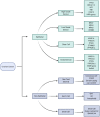Non-invasive Technology Advances in Cancer-A Review of the Advances in the Liquid Biopsy for Endometrial and Ovarian Cancers
- PMID: 34713045
- PMCID: PMC8521848
- DOI: 10.3389/fdgth.2020.573010
Non-invasive Technology Advances in Cancer-A Review of the Advances in the Liquid Biopsy for Endometrial and Ovarian Cancers
Abstract
Improving cancer survival rates globally requires improvements in disease detection and monitoring, with the aim of improving early diagnosis and prediction of disease relapse. Traditional means of detecting and monitoring cancers rely largely on imaging and, where possible, blood-based protein biomarkers, many of which are non-specific. Treatments are being improved by identification of inherited and acquired genomic aberrations in tumors, some of which can be targeted by newly developed therapeutic interventions. Treatment of gynecological malignancy is progressively moving toward personalized therapy, as exemplified by application of PARP-inhibition for patients with BRCA-deficient tubo-ovarian cancers, or checkpoint inhibition in patients with mismatch repair-deficient disease. However, the more recent discovery of a group of biomarkers described under the umbrella term of "liquid biopsy" promises significant improvement in our ability to detect and monitor cancers. The term "liquid biopsy" is used to describe an array of tumor-derived material found in blood plasma and other bodily fluids such as ascites, pleural fluid, saliva, and urine. It includes circulating tumors cells (CTCs), circulating nucleic acids including DNA, messenger RNA and micro RNAs, and extracellular vesicles (EVs). In this review, we discuss recent advancements in liquid biopsy for biomarker detection to help in diagnosis, prognosis, and planning of treatment of ovarian and endometrial cancer.
Keywords: DNA; biomarker; circulating tumor (ctDNA); circulating tumor cell (CTC); microRNA.
Copyright © 2020 Openshaw and McVeigh.
Conflict of interest statement
TM has received speaking honoraria from Roche, Novartis, Astra Zeneca, MSD, and Merck. The remaining author declares that the research was conducted in the absence of any commercial or financial relationships that could be construed as a potential conflict of interest.
Figures



Similar articles
-
Advances and challenges in the use of liquid biopsy in gynaecological oncology.Heliyon. 2024 Oct 15;10(20):e39148. doi: 10.1016/j.heliyon.2024.e39148. eCollection 2024 Oct 30. Heliyon. 2024. PMID: 39492906 Free PMC article. Review.
-
Research progress of CTC, ctDNA, and EVs in cancer liquid biopsy.Front Oncol. 2024 Jan 25;14:1303335. doi: 10.3389/fonc.2024.1303335. eCollection 2024. Front Oncol. 2024. PMID: 38333685 Free PMC article. Review.
-
Liquid biopsy in ovarian cancer: recent advances in circulating extracellular vesicle detection for early diagnosis and monitoring progression.Theranostics. 2019 May 31;9(14):4130-4140. doi: 10.7150/thno.34692. eCollection 2019. Theranostics. 2019. PMID: 31281536 Free PMC article. Review.
-
Circulating Cell-Free DNA or Circulating Tumor DNA in the Management of Ovarian and Endometrial Cancer.Onco Targets Ther. 2019 Dec 27;12:11517-11530. doi: 10.2147/OTT.S227156. eCollection 2019. Onco Targets Ther. 2019. PMID: 31920340 Free PMC article. Review.
-
Cancer diagnosis: from tumor to liquid biopsy and beyond.Lab Chip. 2018 Dec 18;19(1):11-34. doi: 10.1039/c8lc00684a. Lab Chip. 2018. PMID: 30480287 Review.
Cited by
-
circRNAs in Endometrial Cancer-A Promising Biomarker: State of the Art.Int J Mol Sci. 2024 Jun 9;25(12):6387. doi: 10.3390/ijms25126387. Int J Mol Sci. 2024. PMID: 38928094 Free PMC article. Review.
-
Emerging Applications of Liquid Biopsies in Ovarian Cancer.Cureus. 2023 Dec 3;15(12):e49880. doi: 10.7759/cureus.49880. eCollection 2023 Dec. Cureus. 2023. PMID: 38174205 Free PMC article. Review.
-
Clinical Value and Molecular Function of Circulating MicroRNAs in Endometrial Cancer Regulation: A Systematic Review.Cells. 2022 Jun 3;11(11):1836. doi: 10.3390/cells11111836. Cells. 2022. PMID: 35681531 Free PMC article.
-
Non-Invasive Endometrial Cancer Screening through Urinary Fluorescent Metabolome Profile Monitoring and Machine Learning Algorithms.Cancers (Basel). 2024 Sep 14;16(18):3155. doi: 10.3390/cancers16183155. Cancers (Basel). 2024. PMID: 39335127 Free PMC article.
References
-
- Lodish H, Berk A, Zipursky SL. Proto-oncogenes and tumor suppressor genes. In: Freeman WH. editor. Molecular Cell Biology. New York, NY: W. H. Freeman and Company; (2000).
Publication types
LinkOut - more resources
Full Text Sources

